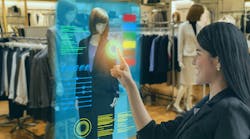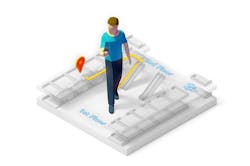Ultra Smart, Ultra Safe: How UWB Can Benefit the Smart Retail Ecosystem
The coronavirus pandemic of 2020 has changed the world in many ways, and one of the most remarkable transformations has been that of consumer retail. Market research from Kantar1 indicates that the number of consumers who did more than half of their shopping online in Europe’s three biggest e-commerce markets rose as much as 80% during the pandemic, and six in 10 respondents say they intend to continue shopping online at the same levels for the foreseeable future, even after the pandemic has passed.
The availability of e-commerce and the fear of viral transmission pose significant threats for the existence of brick-and-mortar outlets. Stores need to adapt their offerings to make consumers feel safer in the “new normal” while still providing that all-important element of retail therapy at a physical store. In the post-COVID era, shopping needs to be quicker, easier, and less congested than ever before.
On top of the current retail trends for personalization and “retailtainment” that create tailored recommendations and unique experiences, retailers are now rushing to create a shopping experience that reduces or eliminates queuing, personal contact, and commonly touched surfaces.
In Finland, Neste has used RFID solutions to fully automate its Easy Deli self-service stores. Items picked from the shelf are deposited in the self-service checkout, where the RFID tags are read and rung up on the register. Once the items have been paid for, the tags are deactivated and the customer leaves the store.
Amazon’s “just walk out” technology is also rolling out globally. Using advanced machine learning, computer vision, and artificial intelligence, Amazon has done away with lines, checkouts, and registers completely. Shoppers activate their Amazon Go app, enter the store, and start shopping. Anything the customer picks up is added to the virtual cart automatically and, when they leave, the items are charged to their Amazon account.
Even now that most shopping occurs online, click-and-collect services remain popular with consumers. With 275 million customers a week, U.S. retail giant Walmart pulls off omni-channel commerce on a staggering scale. By using geolocation via the Walmart mobile app, retail stores are alerted when a customer is about to arrive to pick up their orders. The collection process to get the order ready is triggered in advance and the handoff is much quicker.
Introducing UWB Technology
At this crucial moment in retail history, how does ultra-wideband (UWB) technology fit into the digital wireless technology puzzle, and what can it offer?
UWB, standardized by IEEE 802.15.4z, is an extremely precise ranging and sensing wireless protocol. The ranging is done by performing time-of-flight (ToF) and angle-of-arrival (AoA) measurements between two UWB-enabled devices.
On the radio spectrum, UWB operates far away from the busy industrial, scientific, and medical (ISM) band clustered at around 2.4 GHz. Because it operates between 6.5 and 9 GHz, the technology can safely coexist with other communication frequencies. And, as UWB can send pulses of 2 ns long across a very wide radio spectrum, the technology is able to differentiate multipath signals caused by reflections from nearby objects.
One of the most noteworthy features of UWB over other RF technologies is the extra security it brings against common relay station attacks, where an attacker pretends to be closer to, say, a payment terminal, but in actuality is farther away. For UWB, security features are directly defined in the physical-layer (PHY) circuit used to send and receive packets of data, including cryptography, random number generation, and other techniques to prevent these attacks. Equipped with these capabilities, the technology is well-poised to make a considerable difference to smart retail operations.
To grow the UWB ecosystem and demonstrate the capabilities of fine-ranging technology, an industry coalition called the FiRa Consortium was founded by a group of industry leaders, including NXP, to promote and set standards for UWB technology. The industry consortium is committed to the widespread adoption of interoperable UWB technologies through compliance and certification programs.
Contactless Entry, 24/7
Today’s secure access technologies typically require users to open a doorway by entering a code on a keypad, scanning a palm-print, or tapping a badge on a reader. With UWB set up correctly, the self-service store entrance will open automatically and completely without contact as the customer approaches. A UWB solution can track a shopper’s approach, instantly verify security credentials, and let them pass through for convenient and secure entry and exit.
To make the setup more efficient, and prevent needless opening and closing, operation can be configured with various parameters. Examples include not opening if the person turns away from the door before they reach a certain point, or if they simply stand within a certain distance of the entrance. This is because UWB technology knows if someone is approaching or leaving, and it understands what side of a door they are on. Therefore, the lock and unlock functions happen at the right times, in response to movements and positioning.
Once inside the store, a 360-degree UWB-positioning point-of-sale (POS) system can enable a shopper to securely pay for items without taking their phone out of their bag or pocket.
Easily accessible UWB-enabled devices such as mobile phones will become the key to locking or unlocking doors securely, eliminating the pitfalls of physical keys and other access systems. When battery power is running low, interoperable contactless technologies such as near-field communications (NFC) can also be used as a backup.
Location, Location, Location
Satellite-based GPS services are a familiar technology, especially when traveling or navigating outdoor trails. But certain environments make it hard to acquire or maintain a GPS signal, especially when inside a building or a heavily built-up area.
UWB technology brings GPS-style positioning functionality, with pinpoint accuracy, to indoor environments. This precise positioning to within 10 cm, even in crowded, multipath signal environments, makes it easier to navigate large spaces, such as shopping malls, department stores, and large grocery stores. Using UWB, a shopper may be able to navigate their way to an available parking bay, a specific item on a shelf, or even the nearest free bathroom.
Two UWB-enabled devices can also share ranging and positioning data, making it possible for two friends with mobile phones to locate each other with precision (Fig. 1).
Instead of using today’s computer-vision technologies, high-precision positioning could be used to monitor foot traffic, alerting the retailer when checkout lines are long or where store layout and stock placement may need adjustment. Following the guidelines that users specify for sharing their data, advertising displays could present tailored content and offers based on the people nearby, or even play a medley of the customers’ favorite songs (Fig. 2). Entertainment venues can personalize recommendations and advertisements during events.
The Future of the Smart Retail Ecosystem
Although the retail industry as a whole is characterized as one that’s in a state of constant change, current circumstances have ushered in sweeping modifications as an urgent necessity. Although some might see the hurried migration to online shopping as a threat, the innovators will view this moment as an opportunity to enhance customer offerings, streamline operations, and engage with customers in new and exciting ways.
More retailers are listening to the call for Smart Retail solutions and appreciate that they need support and guidance to implement them as painlessly and efficiently as possible. Advanced technology such as UWB solutions could help eliminate the friction from the in-store shopper journey.
Many of today’s Smart Retail solutions are hardware-dependent and often tied to a fixed location, which doesn’t facilitate a truly mobile and seamless experience. UWB technology's ability to deliver unprecedented accuracy and security when measuring the distance to a target or determining position is unique, offering many possibilities to make today’s retail applications easier to develop and more consumer-friendly. With any luck, it will also transform how people shop and pay for consumer goods in ways that perhaps the industry hasn’t yet even imagined.
For more information, visit www.nxp.com/uwb.
Charles Dachs is Vice President of Secure Embedded Transactions at NXP Semiconductors.
Reference


